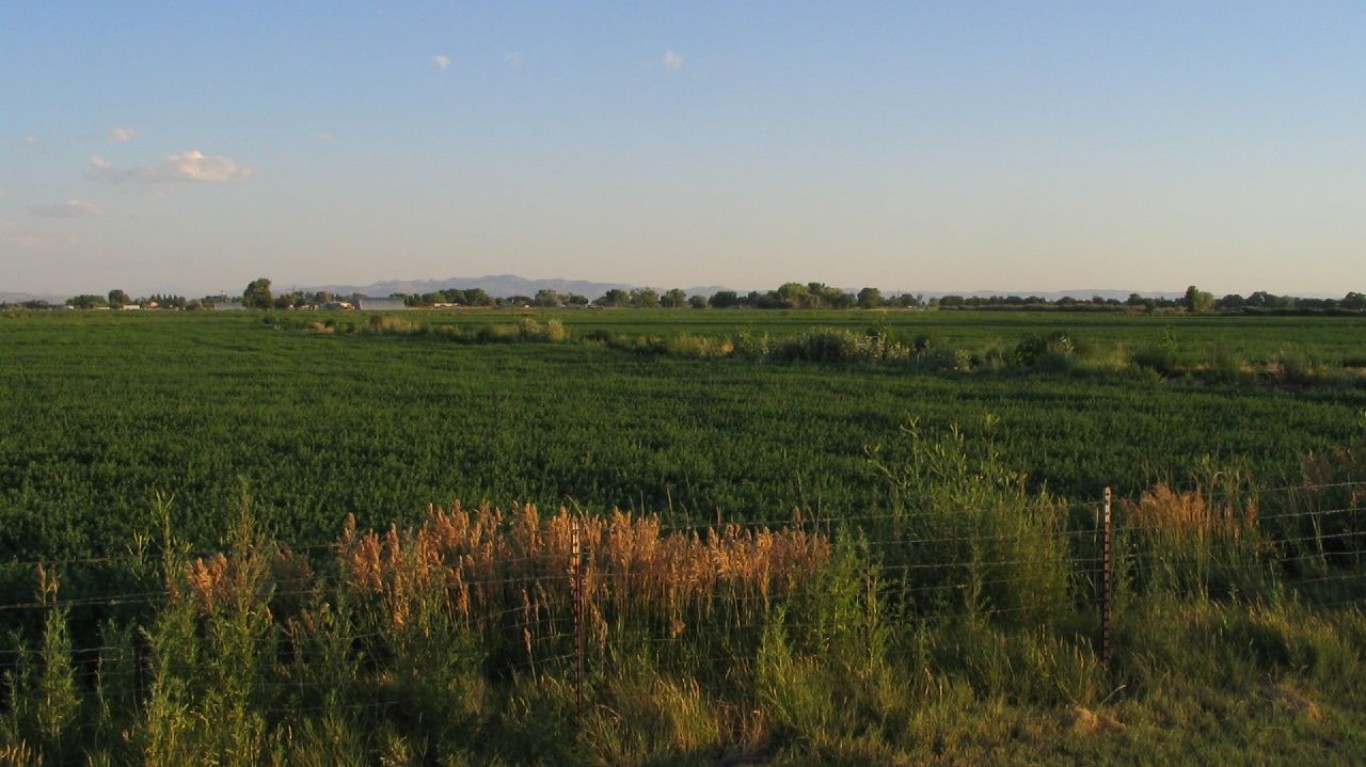
Tens of millions of Americans suffer from nasal allergies caused by exposure to trees, grass, and weed pollens. Additionally, approximately 37% of Americans live in a county with ragweed pollen — a seasonal allergen — and unhealthy levels of ozone, which can induce allergic reactions such as itchy eyes, nasal congestion, and watery eyes in people with nasal allergies. Living in such areas can contribute to negative health effects in young children, older adults, people who work or exercise outside, people with asthma, and other sensitive groups.
Ground-level ozone is the main ingredient in smog. The degree of exposure to harmful smog and ragweed pollen varies throughout the country and can be made worse by pollution. Areas with ragweed pollen and a high number of unhealthy ozone days are worse for people with nasal allergies and asthma, and tend to be the parts of the country most vulnerable to climate change.
To determine the worst county for allergies in every state, 24/7 Wall St. ranked counties according to the average number of unhealthy ozone days and the presence of ragweed pollen with data from the Environmental Protection Agency and the Center for Invasive Species and Ecosystem Health at the University of Georgia.
Click here to see the full list of the counties with the worst allergies in every state.
Click here to see our detailed findings and methodology.

1. Alabama: Mobile County
> County seat: Mobile
> Est. adults with asthma: 31,175
> Average fine particle concentration: 10.8 µg/m3 (42nd of 67 AL counties)
> Population living in urban area: 80.0% (4th of 67 AL counties)
[in-text-ad]

2. Arizona: Maricopa County
> County seat: Phoenix
> Est. adults with asthma: 285,010
> Average fine particle concentration: 10.6 µg/m3 (2nd of 15 AZ counties)
> Population living in urban area: 97.6% (1st of 15 AZ counties)

3. Arkansas: Crittenden County
> County seat: Marion
> Est. adults with asthma: 3,598
> Average fine particle concentration: 10.1 µg/m3 (26th of 75 AR counties)
> Population living in urban area: 79.1% (3rd of 75 AR counties)

4. California: Riverside County
> County seat: Riverside
> Est. adults with asthma: 131,697
> Average fine particle concentration: 14.8 µg/m3 (6th of 58 CA counties)
> Population living in urban area: 95.4% (12th of 58 CA counties)
[in-text-ad-2]

5. Colorado: Jefferson County
> County seat: Golden
> Est. adults with asthma: 39,791
> Average fine particle concentration: 8.4 µg/m3 (4th of 64 CO counties)
> Population living in urban area: 93.1% (5th of 64 CO counties)

6. Connecticut: Fairfield County
> County seat: N/A
> Est. adults with asthma: 75,559
> Average fine particle concentration: 10.0 µg/m3 (1st of 08 CT counties)
> Population living in urban area: 95.4% (2nd of 08 CT counties)
[in-text-ad]

7. Delaware: New Castle County
> County seat: Wilmington
> Est. adults with asthma: 39,523
> Average fine particle concentration: 10.0 µg/m3 (1st of 03 DE counties)
> Population living in urban area: 95.4% (1st of 03 DE counties)

8. Florida: Hillsborough County
> County seat: Tampa
> Est. adults with asthma: 75,195
> Average fine particle concentration: 7.1 µg/m3 (58th of 67 FL counties)
> Population living in urban area: 96.5% (9th of 67 FL counties)

9. Georgia: Fulton County
> County seat: Atlanta
> Est. adults with asthma: 70,671
> Average fine particle concentration: 12.0 µg/m3 (1st of 159 GA counties)
> Population living in urban area: 98.9% (5th of 159 GA counties)
[in-text-ad-2]

10. Hawaii: Honolulu County
> County seat: Honolulu
> Est. adults with asthma: 77,379
> Average fine particle concentration: 0.0 µg/m3 (. of 05 HI counties)
> Population living in urban area: 99.1% (1st of 05 HI counties)

11. Idaho: Ada County
> County seat: Boise
> Est. adults with asthma: 29,036
> Average fine particle concentration: 10.6 µg/m3 (3rd of 44 ID counties)
> Population living in urban area: 94.5% (1st of 44 ID counties)
[in-text-ad]

12. Illinois: Lake County
> County seat: Waukegan
> Est. adults with asthma: 43,992
> Average fine particle concentration: 12.6 µg/m3 (5th of 102 IL counties)
> Population living in urban area: 98.7% (3rd of 102 IL counties)

13. Indiana: Porter County
> County seat: Valparaiso
> Est. adults with asthma: 13,126
> Average fine particle concentration: 12.7 µg/m3 (7th of 92 IN counties)
> Population living in urban area: 79.2% (13th of 92 IN counties)

14. Iowa: Harrison County
> County seat: Logan
> Est. adults with asthma: 842
> Average fine particle concentration: 8.9 µg/m3 (53rd of 99 IA counties)
> Population living in urban area: 18.9% (75th of 99 IA counties)
[in-text-ad-2]

15. Kansas: Sedgwick County
> County seat: Wichita
> Est. adults with asthma: 32,513
> Average fine particle concentration: 10.0 µg/m3 (4th of 105 KS counties)
> Population living in urban area: 92.3% (3rd of 105 KS counties)

16. Kentucky: Campbell County
> County seat: Alexandria & Newport
> Est. adults with asthma: 8,513
> Average fine particle concentration: 11.7 µg/m3 (13th of 120 KY counties)
> Population living in urban area: 84.7% (5th of 120 KY counties)
[in-text-ad]

17. Louisiana: Livingston Parish
> County seat: Livingston
> Est. adults with asthma: 8,200
> Average fine particle concentration: 9.7 µg/m3 (8th of 64 LA counties)
> Population living in urban area: 58.9% (27th of 64 LA counties)

18. Maine: Knox County
> County seat: Rockland
> Est. adults with asthma: 3,627
> Average fine particle concentration: 7.2 µg/m3 (10th of 16 ME counties)
> Population living in urban area: 32.1% (7th of 16 ME counties)

19. Massachusetts: Hampden County
> County seat: Springfield
> Est. adults with asthma: 37,020
> Average fine particle concentration: 8.2 µg/m3 (2nd of 14 MA counties)
> Population living in urban area: 91.4% (6th of 14 MA counties)
[in-text-ad-2]

20. Michigan: Allegan County
> County seat: Allegan
> Est. adults with asthma: 8,708
> Average fine particle concentration: 11.0 µg/m3 (14th of 83 MI counties)
> Population living in urban area: 35.5% (43rd of 83 MI counties)

21. Minnesota: Lyon County
> County seat: Marshall
> Est. adults with asthma: 1,430
> Average fine particle concentration: 6.8 µg/m3 (46th of 87 MN counties)
> Population living in urban area: 52.1% (30th of 87 MN counties)
[in-text-ad]

22. Mississippi: Jackson County
> County seat: Pascagoula
> Est. adults with asthma: 8,314
> Average fine particle concentration: 10.1 µg/m3 (21st of 82 MS counties)
> Population living in urban area: 72.7% (6th of 82 MS counties)

23. Missouri: St. Charles County
> County seat: St. Charles
> Est. adults with asthma: 27,563
> Average fine particle concentration: 11.7 µg/m3 (2nd of 115 MO counties)
> Population living in urban area: 94.2% (4th of 115 MO counties)

24. Montana: Flathead County
> County seat: Kalispell
> Est. adults with asthma: 6,538
> Average fine particle concentration: 8.9 µg/m3 (3rd of 56 MT counties)
> Population living in urban area: 48.5% (18th of 56 MT counties)
[in-text-ad-2]

25. Nebraska: Douglas County
> County seat: Omaha
> Est. adults with asthma: 28,992
> Average fine particle concentration: 9.5 µg/m3 (1st of 93 NE counties)
> Population living in urban area: 97.8% (1st of 93 NE counties)

26. Nevada: Churchill County
> County seat: Fallon
> Est. adults with asthma: 1,501
> Average fine particle concentration: 7.4 µg/m3 (6th of 17 NV counties)
> Population living in urban area: 65.3% (6th of 17 NV counties)
[in-text-ad]

27. New Hampshire: Coos County
> County seat: Lancaster
> Est. adults with asthma: 2,714
> Average fine particle concentration: 6.2 µg/m3 (10th of 10 NH counties)
> Population living in urban area: 33.8% (7th of 10 NH counties)

28. New Jersey: Bergen County
> County seat: Hackensack
> Est. adults with asthma: 52,403
> Average fine particle concentration: 9.9 µg/m3 (9th of 21 NJ counties)
> Population living in urban area: 99.9% (4th of 21 NJ counties)

29. New Mexico: Doña Ana County
> County seat: Las Cruces
> Est. adults with asthma: 15,746
> Average fine particle concentration: 7.8 µg/m3 (1st of 33 NM counties)
> Population living in urban area: 80.7% (6th of 33 NM counties)
[in-text-ad-2]

30. New York: Suffolk County
> County seat: Riverhead
> Est. adults with asthma: 115,204
> Average fine particle concentration: 9.0 µg/m3 (18th of 62 NY counties)
> Population living in urban area: 97.4% (8th of 62 NY counties)

31. North Carolina: Mecklenburg County
> County seat: Charlotte
> Est. adults with asthma: 62,577
> Average fine particle concentration: 11.3 µg/m3 (1st of 100 NC counties)
> Population living in urban area: 98.9% (1st of 100 NC counties)
[in-text-ad]

32. North Dakota: Dunn County
> County seat: Manning
> Est. adults with asthma: 296
> Average fine particle concentration: 4.4 µg/m3 (53rd of 53 ND counties)
> Population living in urban area: 0.0% (15th of 53 ND counties)

33. Ohio: Geauga County
> County seat: Chardon
> Est. adults with asthma: 7,131
> Average fine particle concentration: 11.6 µg/m3 (33rd of 88 OH counties)
> Population living in urban area: 36.0% (66th of 88 OH counties)

34. Oklahoma: Oklahoma County
> County seat: Oklahoma City
> Est. adults with asthma: 54,026
> Average fine particle concentration: 10.0 µg/m3 (9th of 77 OK counties)
> Population living in urban area: 93.7% (2nd of 77 OK counties)
[in-text-ad-2]

35. Oregon: Clackamas County
> County seat: Oregon City
> Est. adults with asthma: 34,379
> Average fine particle concentration: 9.2 µg/m3 (2nd of 36 OR counties)
> Population living in urban area: 81.9% (5th of 36 OR counties)

36. Pennsylvania: Bucks County
> County seat: Doylestown
> Est. adults with asthma: 50,192
> Average fine particle concentration: 10.1 µg/m3 (42nd of 67 PA counties)
> Population living in urban area: 91.2% (6th of 67 PA counties)
[in-text-ad]

37. Rhode Island: Washington County
> County seat: South Kingstown
> Est. adults with asthma: 11,391
> Average fine particle concentration: 6.4 µg/m3 (5th of 05 RI counties)
> Population living in urban area: 69.2% (5th of 05 RI counties)

38. South Carolina: Spartanburg County
> County seat: Spartanburg
> Est. adults with asthma: 18,420
> Average fine particle concentration: 9.5 µg/m3 (43rd of 46 SC counties)
> Population living in urban area: 72.6% (8th of 46 SC counties)

39. South Dakota: Meade County
> County seat: Sturgis
> Est. adults with asthma: 1,714
> Average fine particle concentration: 5.5 µg/m3 (37th of 66 SD counties)
> Population living in urban area: 62.0% (14th of 66 SD counties)
[in-text-ad-2]

40. Tennessee: Shelby County
> County seat: Memphis
> Est. adults with asthma: 62,822
> Average fine particle concentration: 9.5 µg/m3 (81st of 95 TN counties)
> Population living in urban area: 97.2% (1st of 95 TN counties)

41. Texas: Harris County
> County seat: Houston
> Est. adults with asthma: 245,241
> Average fine particle concentration: 12.0 µg/m3 (1st of 254 TX counties)
> Population living in urban area: 98.8% (2nd of 254 TX counties)
[in-text-ad]

42. Utah: Salt Lake County
> County seat: Salt Lake City
> Est. adults with asthma: 70,471
> Average fine particle concentration: 8.4 µg/m3 (1st of 29 UT counties)
> Population living in urban area: 99.1% (1st of 29 UT counties)

43. Vermont: Bennington County
> County seat: Bennington & Manchester
> Est. adults with asthma: 3,232
> Average fine particle concentration: 7.7 µg/m3 (4th of 14 VT counties)
> Population living in urban area: 35.5% (4th of 14 VT counties)

44. Virginia: Arlington County
> County seat: Arlington
> Est. adults with asthma: 14,816
> Average fine particle concentration: 9.7 µg/m3 (6th of 133 VA counties)
> Population living in urban area: 100.0% (1st of 133 VA counties)
[in-text-ad-2]

45. Washington: King County
> County seat: Seattle
> Est. adults with asthma: 154,630
> Average fine particle concentration: 7.5 µg/m3 (16th of 39 WA counties)
> Population living in urban area: 96.8% (1st of 39 WA counties)

46. West Virginia: Wood County
> County seat: Parkersburg
> Est. adults with asthma: 7,337
> Average fine particle concentration: 10.6 µg/m3 (5th of 55 WV counties)
> Population living in urban area: 73.2% (4th of 55 WV counties)
[in-text-ad]

47. Wisconsin: Kenosha County
> County seat: Kenosha
> Est. adults with asthma: 12,088
> Average fine particle concentration: 11.2 µg/m3 (4th of 72 WI counties)
> Population living in urban area: 89.3% (3rd of 72 WI counties)

48. Wyoming: Albany County
> County seat: Laramie
> Est. adults with asthma: 2,526
> Average fine particle concentration: 3.7 µg/m3 (19th of 23 WY counties)
> Population living in urban area: 88.1% (2nd of 23 WY counties)
Detailed Findings
Smog forms when pollution from power plants, vehicles, and other sources reacts with ground-level ozone. Rising temperatures and sunlight exposure can speed up this reaction process and contribute to more days of unhealthy smog. In nine of the 10 counties with the highest number of days with unhealthy ozone levels, the temperature rose above 90 degrees fahrenheit for at least 90 days in 2016.
In 16 of the 25 counties with ragweed pollen and the highest number of unhealthy ozone days, the number of 90-plus degree days per year is projected to at least double by 2050. Many counties on this list also receive more exposure to sunlight on an annual basis than the national average. Sunlight also can speed up the smog reaction process.
Dense urban areas tend to be hotter than rural areas and, ultimately, may be worse for individuals with nasal allergies, asthma, and other at-risk groups. In a phenomenon known as the “heat island effect,” building and pavement materials absorb heat less effectively than natural green spaces and result in higher temperatures in built-up areas.
The average temperature in a city with more than 1 million people can be more 5 degrees fahrenheit warmer than its rural surroundings throughout the year, and on some nights, the temperature differential can reach as high as 22 degrees. In the 17 of the 25 counties with the highest number of unhealthy ozone days, the share of residents living in an urban area exceeds the 80.7% national figure.
According to the environmental advocacy group Natural Resources Defense Council, the combination of smog and pollen contributes to more missed days of school and work, more trips to the doctor, higher medical costs, and an increase in premature deaths. In some of the counties with the most unhealthy ozone days, a 25% reduction in the concentration of fine particulate matter in the air is projected to reduce the overall mortality rate by more than 2%, according to data from the Environmental Public Health Tracking Network of the Centers for Disease Control and Prevention.
Methodology
To identify the worst counties for nasal allergies, 24/7 Wall St. reviewed ozone levels in U.S. counties from the Environmental Protection Agency from 2013 to 2017. Counties were ranked on the average annual number of days when the average concentration of ozone exceeded the 2015 Ozone National Ambient Air Quality Standards (0.070 parts per million). Only monitors that performed at least 75% of scheduled observations in at least four of the five years considered were included in the county average. Additionally, only counties where the presence of common ragweed (Ambrosia artemisifolia) pollen has been reported were included. Ragweed pollen data came from the Center for Invasive Species and Ecosystem Health of the University of Georgia. Ragweed pollen data is unavailable for Alaska and Maryland, which were excluded from our analysis. Population data came from the U.S. Census Bureau’s American Community Survey and is a five-year average for 2011 to 2016. Data on the percentage of the county population living in urban areas also came from the U.S. Census Bureau. Data on the number of days above 90 degrees fahrenheit came from the National Environmental Public Health Tracking Network of the Centers for Disease Control and Prevention and is for 2016. The number of adults age 18 and over with asthma is an estimated figure based on the adult asthma rate from the CDC and five-year population data from the ACS for 2011 to 2016.
The Average American Has No Idea How Much Money You Can Make Today (Sponsor)
The last few years made people forget how much banks and CD’s can pay. Meanwhile, interest rates have spiked and many can afford to pay you much more, but most are keeping yields low and hoping you won’t notice.
But there is good news. To win qualified customers, some accounts are paying almost 10x the national average! That’s an incredible way to keep your money safe and earn more at the same time. Our top pick for high yield savings accounts includes other benefits as well. You can earn up to 3.80% with a Checking & Savings Account today Sign up and get up to $300 with direct deposit. No account fees. FDIC Insured.
Click here to see how much more you could be earning on your savings today. It takes just a few minutes to open an account to make your money work for you.
Our top pick for high yield savings accounts includes other benefits as well. You can earn up to 4.00% with a Checking & Savings Account from Sofi. Sign up and get up to $300 with direct deposit. No account fees. FDIC Insured.
Thank you for reading! Have some feedback for us?
Contact the 24/7 Wall St. editorial team.
 24/7 Wall St.
24/7 Wall St. 24/7 Wall St.
24/7 Wall St. 24/7 Wall St.
24/7 Wall St. 24/7 Wall St.
24/7 Wall St. 24/7 Wall St.
24/7 Wall St.



